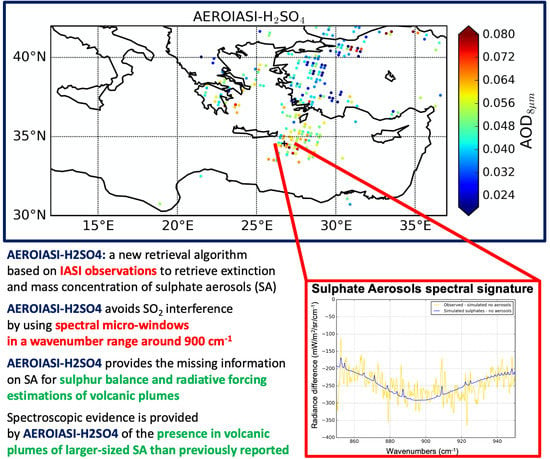Quantitative Retrieval of Volcanic Sulphate Aerosols from IASI Observations
Abstract
1. Introduction
2. Data and Methods
2.1. The IASI Instrument
2.2. AEROIASI-H2SO4 Retrieval Scheme
2.3. The Eruption of Mount Etna of 18–20 March 2012
2.4. Plume Correlative Data
2.4.1. MODIS AOD Observations
2.4.2. IASI SO Observations
2.4.3. CHIMERE SO Simulations
3. Results and Discussion
3.1. SA AOD
3.2. SA Mass
3.3. Sensitivity and Precision of AEROIASI-H2SO4
4. Conclusions and Perspectives
Author Contributions
Funding
Institutional Review Board Statement
Informed Consent Statement
Data Availability Statement
Acknowledgments
Conflicts of Interest
References
- Roberts, T.; Vignelles, D.; Liuzzo, M.; Giudice, G.; Aiuppa, A.; Coltelli, M.; Salerno, G.; Chartier, M.; Couté, B.; Berthet, G.; et al. The primary volcanic aerosol emission from Mt Etna: Size-resolved particles with SO2 and role in plume reactive halogen chemistry. Geochim. Cosmochim. Acta 2018, 222, 74–93. [Google Scholar] [CrossRef]
- Martin, E.; Bekki, S.; Ninin, C.; Bindeman, I. Volcanic sulfate aerosol formation in the troposphere. J. Geophys. Res. Atmos. 2014, 119, 12,660–12,673. [Google Scholar] [CrossRef]
- Robock, A. Volcanic eruptions and climate. Rev. Geophys. 2000, 38, 191–219. [Google Scholar] [CrossRef]
- Vernier, J.P.; Thomason, L.W.; Pommereau, J.P.; Bourassa, A.; Pelon, J.; Garnier, A.; Hauchecorne, A.; Blanot, L.; Trepte, C.; Degenstein, D.; et al. Major influence of tropical volcanic eruptions on the stratospheric aerosol layer during the last decade. Geophys. Res. Lett. 2011, 38. [Google Scholar] [CrossRef]
- Ridley, D.A.; Solomon, S.; Barnes, J.E.; Burlakov, V.D.; Deshler, T.; Dolgii, S.I.; Herber, A.B.; Nagai, T.; Neely, R.R.; Nevzorov, A.V.; et al. Total volcanic stratospheric aerosol optical depths and implications for global climate change. Geophys. Res. Lett. 2014, 41, 7763–7769. [Google Scholar] [CrossRef]
- Sellitto, P.; Zanetel, C.; di Sarra, A.; Salerno, G.; Tapparo, A.; Meloni, D.; Pace, G.; Caltabiano, T.; Briole, P.; Legras, B. The impact of Mount Etna sulfur emissions on the atmospheric composition and aerosol properties in the central Mediterranean: A statistical analysis over the period 2000–2013 based on observations and Lagrangian modelling. Atmos. Environ. 2017, 148, 77–88. [Google Scholar] [CrossRef]
- Michaud, J.P.; Grove, J.S.; Krupitsky, D. Emergency department visits and vog-related air quality in Hilo, Hawai’i. Environ. Res. 2004, 95, 11–19. [Google Scholar] [CrossRef]
- Aiuppa, A.; Bellomo, S.; Brusca, L.; D’Alessandro, W.; Di Paola, R.; Longo, M. Major-ion bulk deposition around an active volcano (Mt. Etna, Italy). Bull. Volcanol. 2006, 68, 255–265. [Google Scholar] [CrossRef]
- Carslaw, K.S.; Lee, L.A.; Reddington, C.L.; Pringle, K.J.; Rap, A.; Forster, P.M.; Mann, G.W.; Spracklen, D.V.; Woodhouse, M.T.; Regayre, L.A.; et al. Large contribution of natural aerosols to uncertainty in indirect forcing. Nature 2013, 503, 67–71. [Google Scholar] [CrossRef] [PubMed]
- Carn, S.; Clarisse, L.; Prata, A. Multi-decadal satellite measurements of global volcanic degassing. J. Volcanol. Geotherm. Res. 2016, 311, 99–134. [Google Scholar] [CrossRef]
- Clarisse, L.; Prata, F. Chapter 11—Infrared Sounding of Volcanic Ash. In Volcanic Ash; Mackie, S., Cashman, K., Ricketts, H., Rust, A., Watson, M., Eds.; Elsevier: Amsterdam, The Netherlands, 2016; pp. 189–215. [Google Scholar] [CrossRef]
- Carn, S.; Krotkov, N. Chapter 12—Ultraviolet Satellite Measurements of Volcanic Ash. In Volcanic Ash; Mackie, S., Cashman, K., Ricketts, H., Rust, A., Watson, M., Eds.; Elsevier: Amsterdam, The Netherlands, 2016; pp. 217–231. [Google Scholar] [CrossRef]
- Günther, A.; Höpfner, M.; Sinnhuber, B.M.; Griessbach, S.; Deshler, T.; von Clarmann, T.; Stiller, G. MIPAS observations of volcanic sulfate aerosol and sulfur dioxide in the stratosphere. Atmos. Chem. Phys. 2018, 18, 1217–1239. [Google Scholar] [CrossRef]
- Haywood, J.M.; Jones, A.; Clarisse, L.; Bourassa, A.; Barnes, J.; Telford, P.; Bellouin, N.; Boucher, O.; Agnew, P.; Clerbaux, C.; et al. Observations of the eruption of the Sarychev volcano and simulations using the HadGEM2 climate model. J. Geophys. Res. Atmos. 2010, 115. [Google Scholar] [CrossRef]
- Karagulian, F.; Clarisse, L.; Clerbaux, C.; Prata, A.J.; Hurtmans, D.; Coheur, P.F. Detection of volcanic SO2, ash, and H2SO4 using the Infrared Atmospheric Sounding Interferometer (IASI). J. Geophys. Res. Atmos. 2010, 115, D00L02. [Google Scholar] [CrossRef]
- Sellitto, P.; Legras, B. Sensitivity of thermal infrared nadir instruments to the chemical and microphysical properties of UTLS secondary sulfate aerosols. Atmos. Meas. Tech. 2016, 9, 115–132. [Google Scholar] [CrossRef]
- Clarisse, L.; Coheur, P.F.; Prata, F.; Hadji-Lazaro, J.; Hurtmans, D.; Clerbaux, C. A unified approach to infrared aerosol remote sensing and type specification. Atmos. Chem. Phys. 2013, 13, 2195–2221. [Google Scholar] [CrossRef]
- Cuesta, J.; Eremenko, M.; Flamant, C.; Dufour, G.; Laurent, B.; Bergametti, G.; Höpfner, M.; Orphal, J.; Zhou, D. Three-dimensional distribution of a major desert dust outbreak over East Asia in March 2008 derived from IASI satellite observations. J. Geophys. Res. Atmos. 2015, 120, 7099–7127. [Google Scholar] [CrossRef]
- Clerbaux, C.; Boynard, A.; Clarisse, L.; George, M.; Hadji-Lazaro, J.; Herbin, H.; Hurtmans, D.; Pommier, M.; Razavi, A.; Turquety, S.; et al. Monitoring of atmospheric composition using the thermal infrared IASI/MetOp sounder. Atmos. Chem. Phys. 2009, 9, 6041–6054. [Google Scholar] [CrossRef]
- Capelle, V.; Chédin, A.; Siméon, M.; Tsamalis, C.; Pierangelo, C.; Pondrom, M.; Crevoisier, C.; Crepeau, L.; Scott, N.A. Evaluation of IASI-derived dust aerosol characteristics over the tropical belt. Atmos. Chem. Phys. 2014, 14, 9343–9362. [Google Scholar] [CrossRef]
- Ventress, L.J.; McGarragh, G.; Carboni, E.; Smith, A.J.; Grainger, R.G. Retrieval of ash properties from IASI measurements. Atmos. Meas. Tech. 2016, 9, 5407–5422. [Google Scholar] [CrossRef]
- Tikhonov, A.N. On the solution of ill-posed problems and the method of regularization. Dokl. Akad. Nauk SSSR 1963, 151, 501–504. [Google Scholar]
- Rodgers, C.D. Inverse Methods for Atmospheric Sounding: Theory and Practice; Series on Atmospheric Oceanic and Planetary Physics; World Scientific: London, UK, 2000; Volume 2, pp. 43–64. [Google Scholar]
- Stiller, G.P.; von Clarmann, T.; Funke, B.; Glatthor, N.; Hase, F.; Höpfner, M.; Linden, A. Sensitivity of trace gas abundances retrievals from infrared limb emission spectra to simplifying approximations in radiative transfer modelling. J. Quant. Spectrosc. Radiat. Transf. 2002, 72, 249–280. [Google Scholar] [CrossRef]
- Dee, D.P.; Uppala, S.M.; Simmons, A.J.; Berrisford, P.; Poli, P.; Kobayashi, S.; Andrae, U.; Balmaseda, M.A.; Balsamo, G.; Bauer, P.; et al. The ERA-Interim reanalysis: Configuration and performance of the data assimilation system. Q. J. R. Meteorol. Soc. 2011, 137, 553–597. [Google Scholar] [CrossRef]
- Biermann, U.M.; Luo, B.P.; Peter, T. Absorption Spectra and Optical Constants of Binary and Ternary Solutions of H2SO4, HNO3, and H2O in the Mid Infrared at Atmospheric Temperatures. J. Phys. Chem. A 2000, 104, 783–793. [Google Scholar] [CrossRef]
- Kremser, S.; Thomason, L.W.; von Hobe, M.; Hermann, M.; Deshler, T.; Timmreck, C.; Toohey, M.; Stenke, A.; Schwarz, J.P.; Weigel, R.; et al. Stratospheric aerosol—Observations, processes, and impact on climate. Rev. Geophys. 2016, 54, 278–335. [Google Scholar] [CrossRef]
- Sellitto, P.; Guermazi, H.; Carboni, E.; Siddans, R.; Burton, M. Unified quantitative observation of coexisting volcanic sulfur dioxide and sulfate aerosols using ground-based Fourier transform infrared spectroscopy. Atmos. Meas. Tech. 2019, 12, 5381–5389. [Google Scholar] [CrossRef]
- Stiller, G. The Karlsruhe Optimized and Precise Radiative Transfer Algorithm (KOPRA); Wissenschaftliche Berichte, FZKA; Forschungszentrum Karlsruhe: Karlsruhe, Germany, 2000. [Google Scholar]
- Zhou, D.K.; Larar, A.M.; Liu, X.; Smith, W.L.; Strow, L.L.; Yang, P.; Schlüssel, P.; Calbet, X. Global Land Surface Emissivity Retrieved From Satellite Ultraspectral IR Measurements. IEEE Trans. Geosci. Remote Sens. 2011, 49, 1277–1290. [Google Scholar] [CrossRef]
- Carn, S.A.; Froyd, K.D.; Anderson, B.E.; Wennberg, P.; Crounse, J.; Spencer, K.; Dibb, J.E.; Krotkov, N.A.; Browell, E.V.; Hair, J.W.; et al. In situ measurements of tropospheric volcanic plumes in Ecuador and Colombia during TC4. J. Geophys. Res. Atmos. 2011, 116. [Google Scholar] [CrossRef]
- INGV. Bollettino Settimanale sul Monitoraggio Vulcanico, Geochimico e Sismico del Vulcano Etna, 12/03/2012–18/03/2012; Technical Report; INGV: Roma, Italy, 2012. [Google Scholar]
- Carboni, E.; Grainger, R.; Walker, J.; Dudhia, A.; Siddans, R. A new scheme for sulphur dioxide retrieval from IASI measurements: Application to the Eyjafjallajökull eruption of April and May 2010. Atmos. Chem. Phys. 2012, 12, 11417–11434. [Google Scholar] [CrossRef]
- Carboni, E.; Grainger, R.G.; Mather, T.A.; Pyle, D.M.; Thomas, G.E.; Siddans, R.; Smith, A.J.A.; Dudhia, A.; Koukouli, M.E.; Balis, D. The vertical distribution of volcanic SO2 plumes measured by IASI. Atmos. Chem. Phys. 2016, 16, 4343–4367. [Google Scholar] [CrossRef]
- Saunders, R.; Hocking, J.; Turner, E.; Rayer, P.; Rundle, D.; Brunel, P.; Vidot, J.; Roquet, P.; Matricardi, M.; Geer, A.; et al. An update on the RTTOV fast radiative transfer model (currently at version 12). Geosci. Model Dev. 2018, 11, 2717–2737. [Google Scholar] [CrossRef]
- Walker, J.C.; Dudhia, A.; Carboni, E. An effective method for the detection of trace species demonstrated using the MetOp Infrared Atmospheric Sounding Interferometer. Atmos. Meas. Tech. 2011, 4, 1567–1580. [Google Scholar] [CrossRef]
- Mailler, S.; Menut, L.; Khvorostyanov, D.; Valari, M.; Couvidat, F.; Siour, G.; Turquety, S.; Briant, R.; Tuccella, P.; Bessagnet, B.; et al. CHIMERE-2017: From urban to hemispheric chemistry-transport modeling. Geosci. Model Dev. 2017, 10, 2397–2423. [Google Scholar] [CrossRef]
- Lachatre, M.; Mailler, S.; Menut, L.; Turquety, S.; Sellitto, P.; Guermazi, H.; Salerno, G.; Carboni, T.C.E. New strategies for vertical transport in chemistry-transport models: Application to the case of the Mount Etna eruption on March 18, 2012. Geosci. Model Dev. 2020. under review. [Google Scholar] [CrossRef]
- Skamarock, W.C.; Klemp, J.B.; Dudhia, J.; Gill, D.O.; Barker, D.; Duda, M.G.; Powers, J.G. A Description of the Advanced Research WRF Version 3 (No. NCAR/TN-475+STR); Technical Report; University Corporation for Atmospheric Research: Boulder, CO, USA, 2008. [Google Scholar]
- Briant, R.; Tuccella, P.; Deroubaix, A.; Khvorostyanov, D.; Menut, L.; Mailler, S.; Turquety, S. Aerosol–radiation interaction modelling using online coupling between the WRF 3.7.1 meteorological model and the CHIMERE 2016 chemistry-transport model, through the OASIS3-MCT coupler. Geosci. Model Dev. 2017, 10, 927–944. [Google Scholar] [CrossRef]
- Van Leer, B. Towards the ultimate conservative difference scheme. V A second order sequel to Godunov’s method. J. Comput. Phys. 1979, 32, 101–136. [Google Scholar] [CrossRef]
- Després, B.; Lagoutière, F. Un schéma non linéaire anti-dissipatif pour l’équation d’advection linéaire. C. R. l’Académie Sci. Math. 1999, 328, 939–943. [Google Scholar] [CrossRef]
- Salerno, G.G.; Burton, M.; di Grazia, G.; Caltabiano, T.; Oppenheimer, C. Coupling Between Magmatic Degassing and Volcanic Tremor in Basaltic Volcanism. Front. Earth Sci. 2018, 6, 157. [Google Scholar] [CrossRef]
- Vehkamäki, H.; Kulmala, M.; Napari, I.; Lehtinen, K.E.J.; Timmreck, C.; Noppel, M.; Laaksonen, A. An improved parameterization for sulfuric acid–water nucleation rates for tropospheric and stratospheric conditions. J. Geophys. Res. Atmos. 2002, 107, AAC3-1–AAC3-10. [Google Scholar] [CrossRef]
- Steck, T.; von Clarmann, T. Constrained profile retrieval applied to the observation mode of the Michelson Interferometer for Passive Atmospheric Sounding. Appl. Opt. 2001, 40, 3559–3571. [Google Scholar] [CrossRef]
- Guermazi, H.; Sellitto, P.; Serbaji, M.M.; Legras, B.; Rekhiss, F. Assessment of the Combined Sensitivity of Nadir TIR Satellite Observations to Volcanic SO2 and Sulphate Aerosols after a Moderate Stratospheric Eruption. Geosciences 2017, 7, 84. [Google Scholar] [CrossRef]
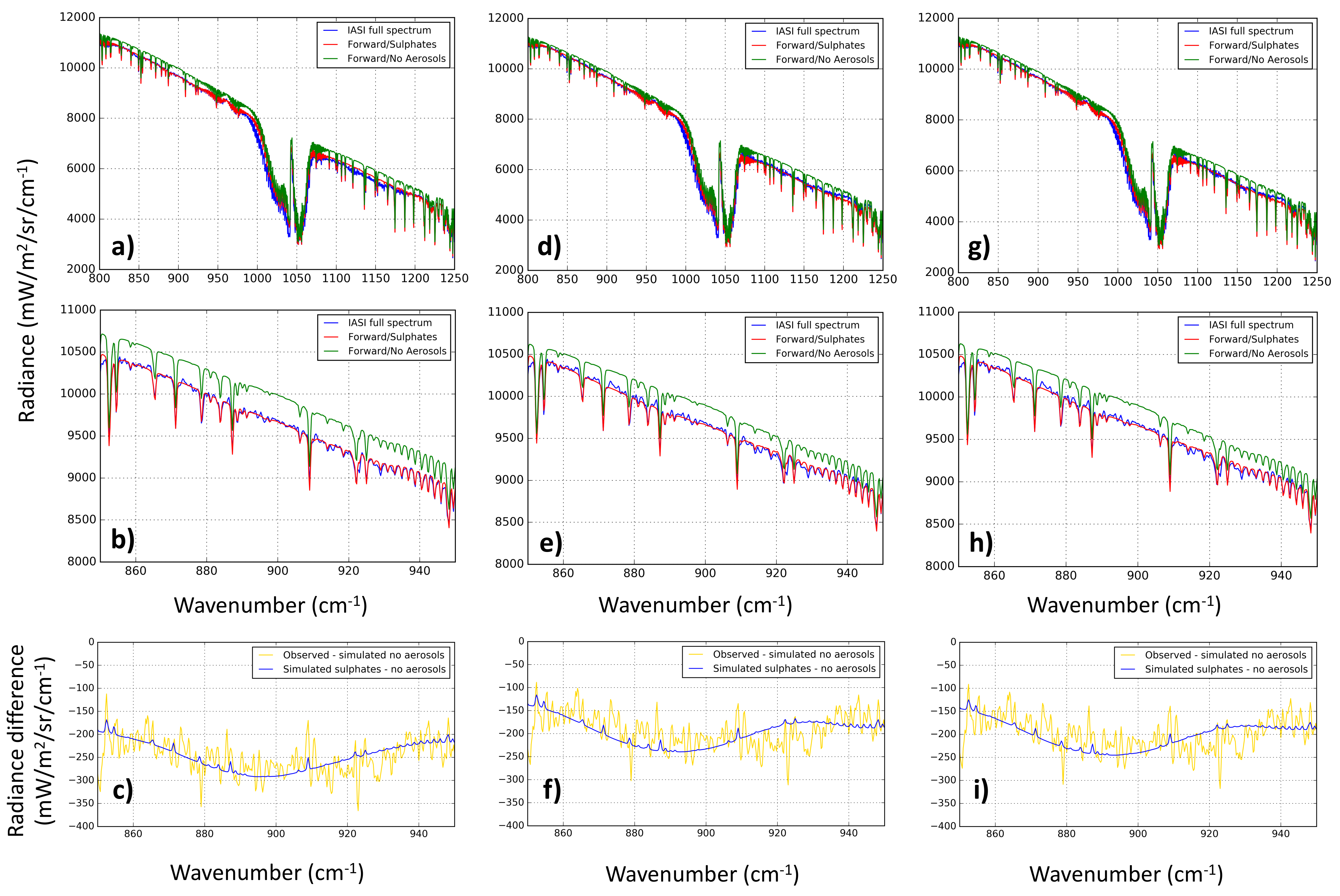
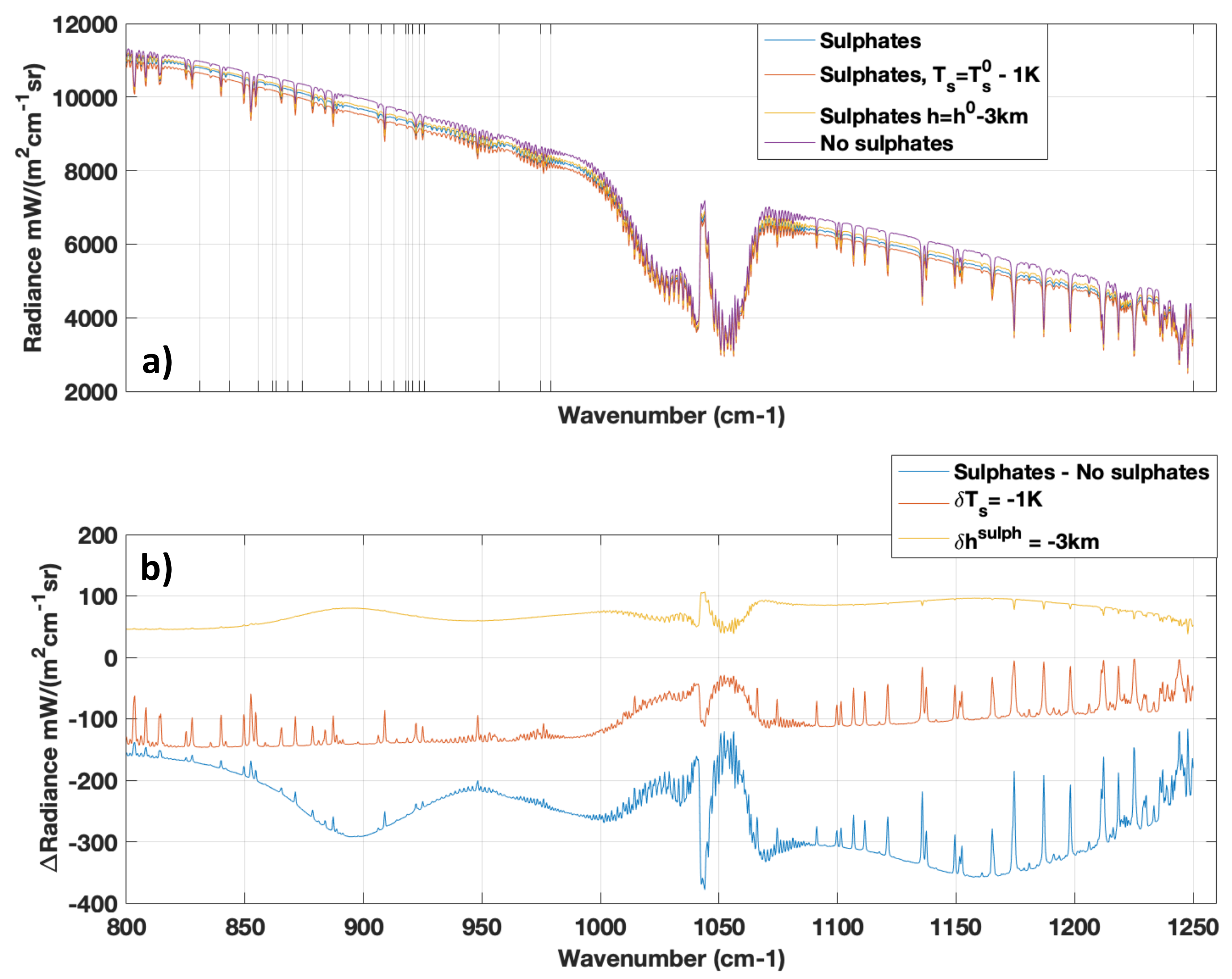
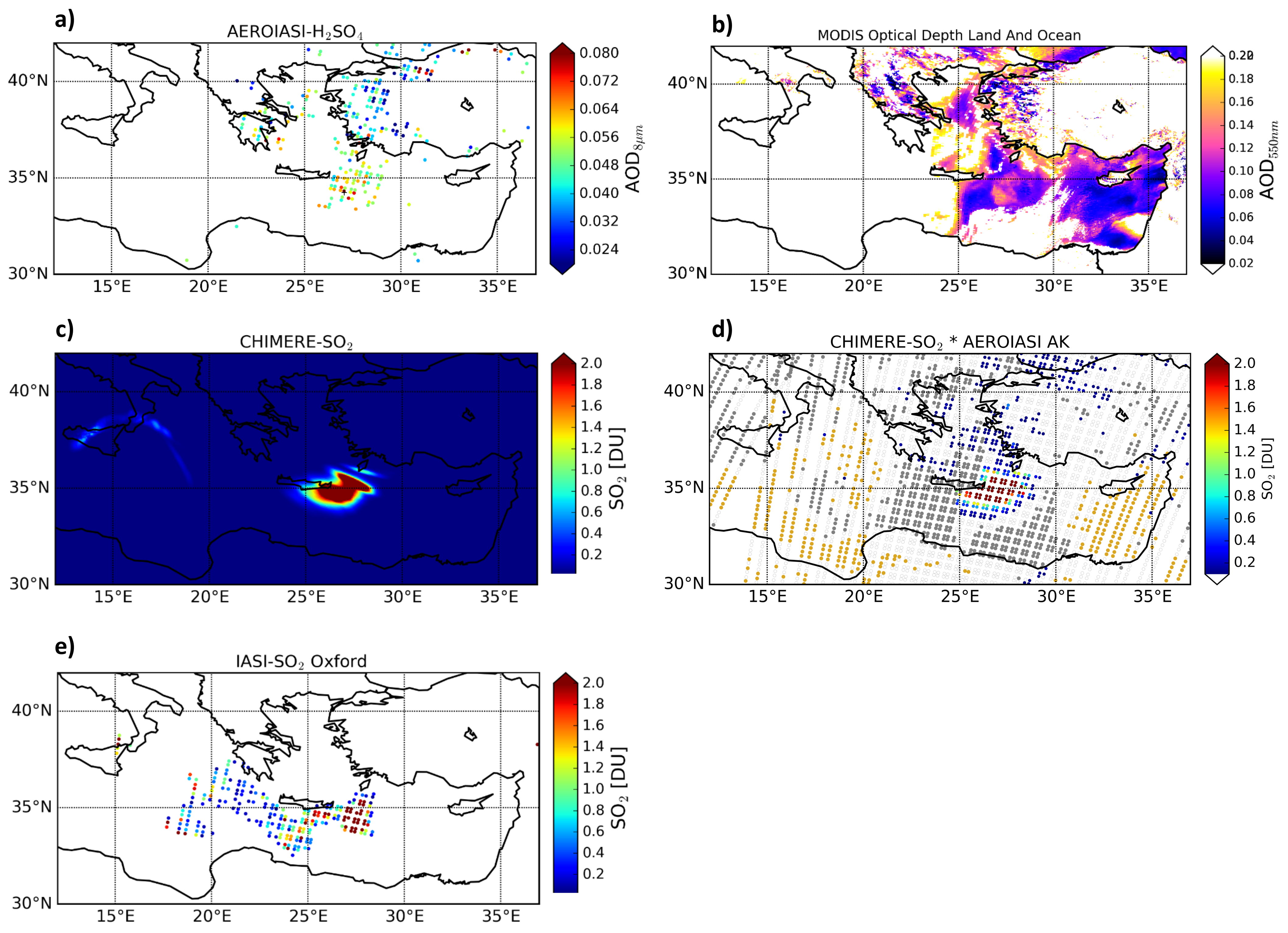
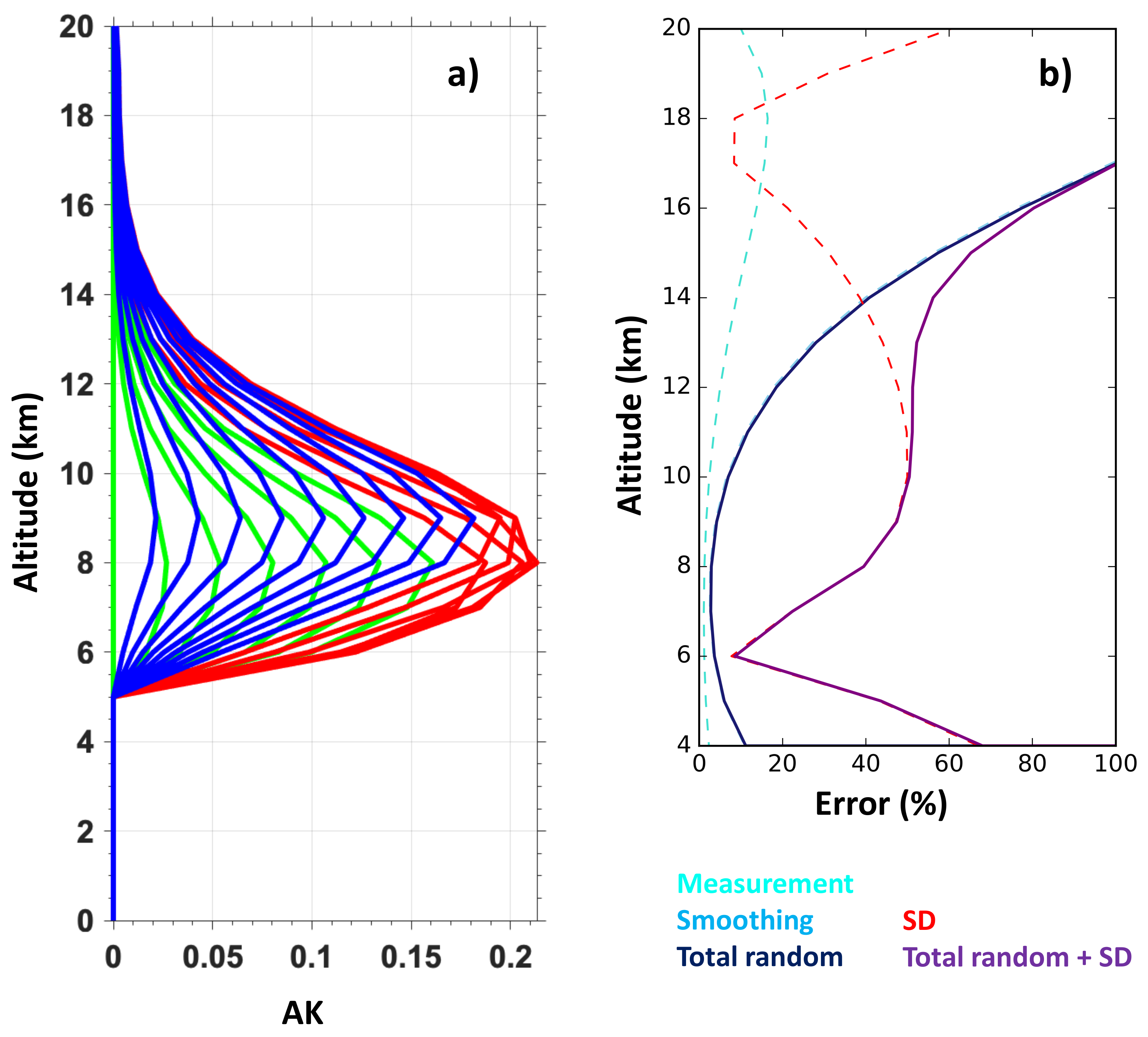
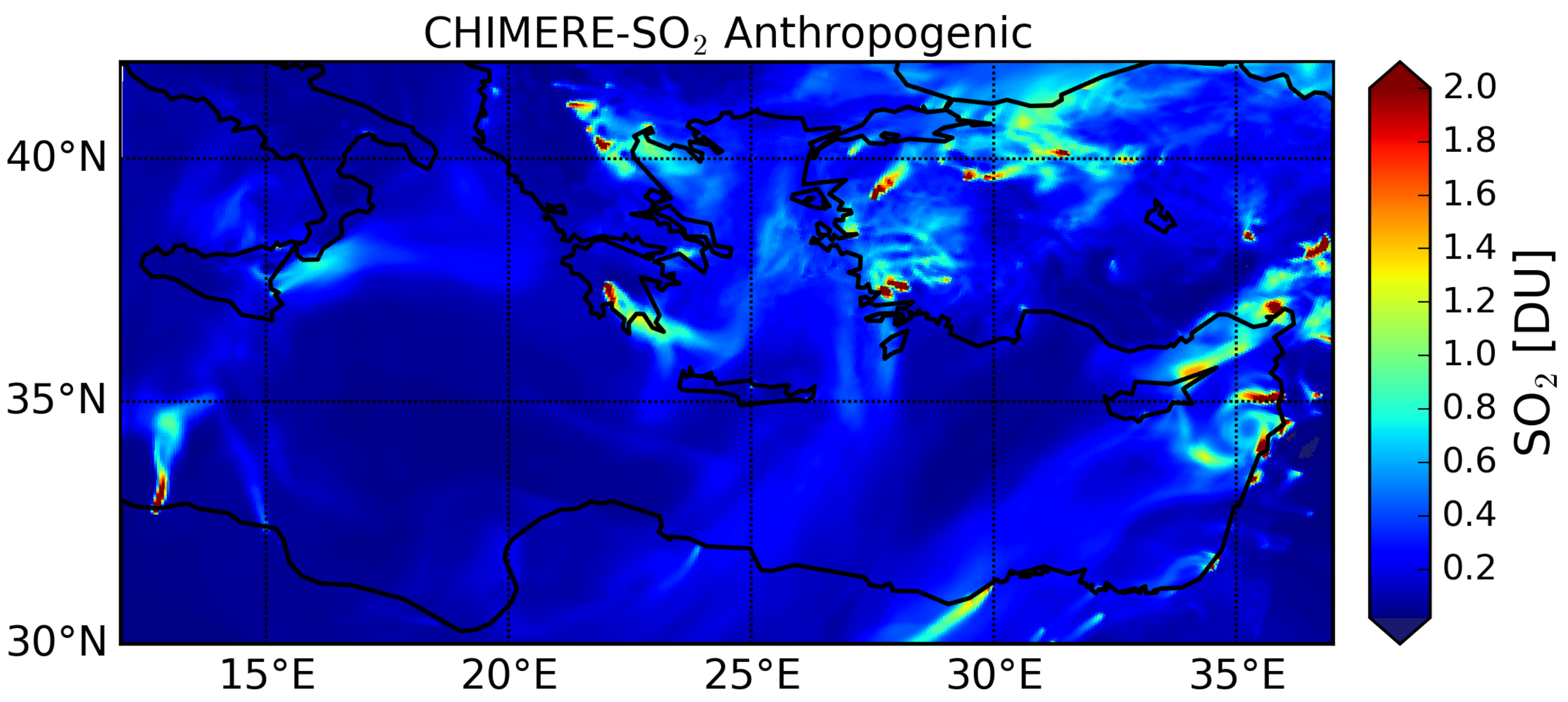
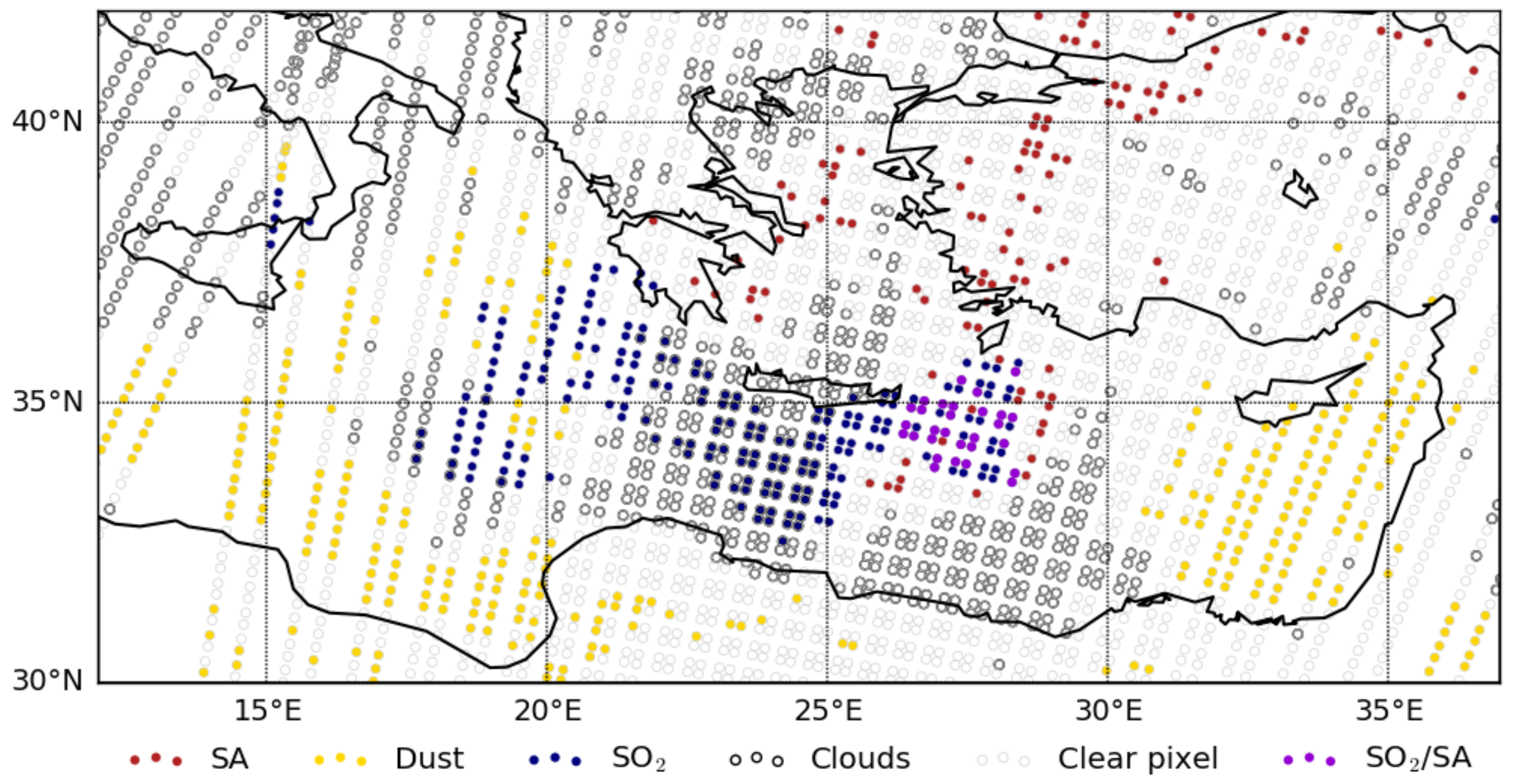
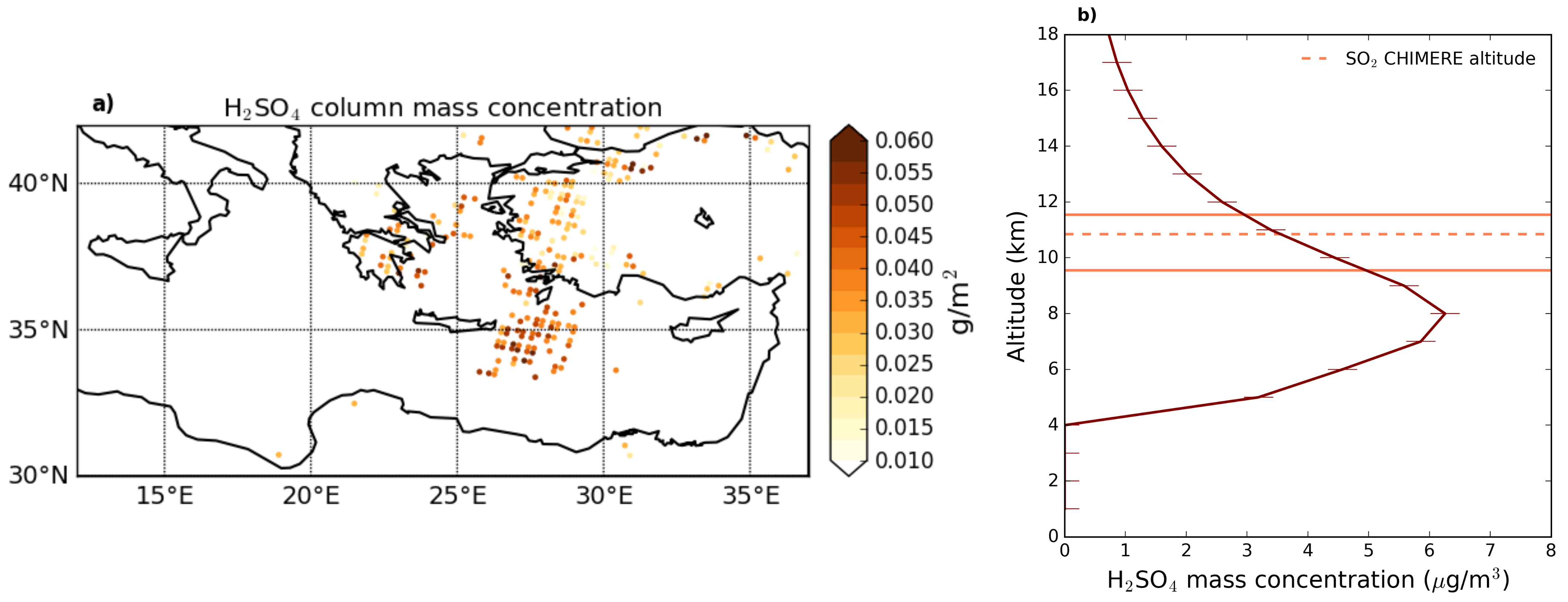
| Input | Description |
|---|---|
| Spectral micro-windows (cm) | (830.75,831.00), (842.75,844.00), (855.00,856.00), (861.50,862.00) |
| (863.00,863.50), (867.25,868.75), (873.25,875.50), (892.00,896.25) | |
| (898.75,905.75), (906.75,908.25), (909.50,916.25), (917.50,918.00) | |
| (918.75,919.25), (920.50,921.00), (922.75,924.50), (925.50,926.00) | |
| (956.75,957.50), (974.50,975.25), (978.00,979.75), (1250.00,1250.50) | |
| Mean radius of the SA layer size distribution | 0.50 μm |
| Standard deviation of the SA layer size distribution | 0.50 |
| SA refractive index | Biermann et al. [26] |
| HSO mixing ratio | 57% |
| A-priori SA profile | 0.2 particles/cm in the altitude range 4–21 km, zero elsewhere |
| R Constraint matrix | Constant with altitude |
| Surface temperature and water vapor profiles, first guess | ERA-Interim reanalyses interpolated for IASI pixels |
Publisher’s Note: MDPI stays neutral with regard to jurisdictional claims in published maps and institutional affiliations. |
© 2021 by the authors. Licensee MDPI, Basel, Switzerland. This article is an open access article distributed under the terms and conditions of the Creative Commons Attribution (CC BY) license (https://creativecommons.org/licenses/by/4.0/).
Share and Cite
Guermazi, H.; Sellitto, P.; Cuesta, J.; Eremenko, M.; Lachatre, M.; Mailler, S.; Carboni, E.; Salerno, G.; Caltabiano, T.; Menut, L.; et al. Quantitative Retrieval of Volcanic Sulphate Aerosols from IASI Observations. Remote Sens. 2021, 13, 1808. https://doi.org/10.3390/rs13091808
Guermazi H, Sellitto P, Cuesta J, Eremenko M, Lachatre M, Mailler S, Carboni E, Salerno G, Caltabiano T, Menut L, et al. Quantitative Retrieval of Volcanic Sulphate Aerosols from IASI Observations. Remote Sensing. 2021; 13(9):1808. https://doi.org/10.3390/rs13091808
Chicago/Turabian StyleGuermazi, Henda, Pasquale Sellitto, Juan Cuesta, Maxim Eremenko, Mathieu Lachatre, Sylvain Mailler, Elisa Carboni, Giuseppe Salerno, Tommaso Caltabiano, Laurent Menut, and et al. 2021. "Quantitative Retrieval of Volcanic Sulphate Aerosols from IASI Observations" Remote Sensing 13, no. 9: 1808. https://doi.org/10.3390/rs13091808
APA StyleGuermazi, H., Sellitto, P., Cuesta, J., Eremenko, M., Lachatre, M., Mailler, S., Carboni, E., Salerno, G., Caltabiano, T., Menut, L., Serbaji, M. M., Rekhiss, F., & Legras, B. (2021). Quantitative Retrieval of Volcanic Sulphate Aerosols from IASI Observations. Remote Sensing, 13(9), 1808. https://doi.org/10.3390/rs13091808








